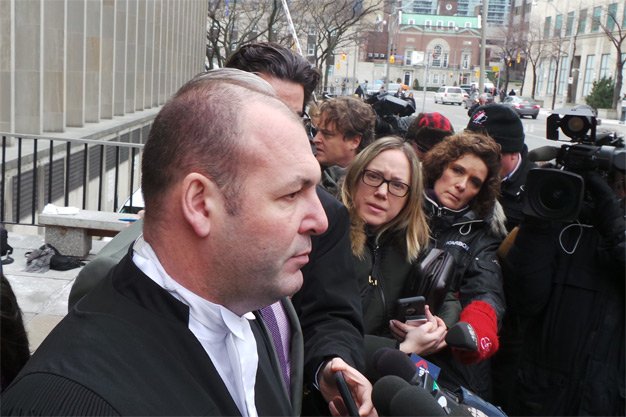
At midnight on July 27, 2013, Toronto police constable James Forcillo killed teenager Sammy Yatim. At 12:56 pm today, a jury of seven women and four men found Forcillo guilty of attempting to murder Yatim but not guilty of actually murdering him.
Because juries do not conduct their deliberations in public and do not issue reasons, we can’t know for sure why this one decided as it did. But if we presume that they correctly applied the law as the judge explained it to them, there are some things we can infer. Chief among these is that they probably concluded that certain actions that may have been reasonable when Yatim was standing up were substantially less excusable when he was lying down.
Forcillo faced two charges, second-degree murder and attempted murder, each relating to a distinct period of his brief encounter with Yatim. The murder charge concerned the first three bullets that he fired while Yatim was standing in the streetcar doorway brandishing a knife. One of the bullets shattered Yatim’s spine and another pierced his heart together, those wounds were fatal.
Having been paralyzed, Yatim fell to the streetcar floor, and after a pause of five and a half seconds, Forcillo shot him again. The attempted murder charge concerned this second volley of six shots, only one of which missed Yatim the rest hit non-vital areas like his groin and his buttocks, and the court heard that they didn’t contribute to or accelerate his death.
The court did, however, hear expert testimony that Yatim was already dead when another, unidentified officer hit him with a taser. So Justice Edward Then left it to the jury to determine, on the evidence, whether Yatim was still alive when he was struck by the second volley: the attempted murder charge would depend on it. In other words, it was about Forcillo trying to kill someone who was already on his way to death but not yet quite there.
There were two possible defences to each charge, and it was up to the Crown to prove beyond a reasonable doubt that neither applied in each case:
- Justification: A police officer is justified in deploying force when they’re 1) doing something to enforce a law, 2) acting on reasonable grounds, 3) using no more force than necessary, and 4) if the force is intended or likely to cause death or bodily harm, they reasonably believe it’s necessary to protect themselves or someone in their protection from same. As the judge put it, the jury had to consider “whether it was reasonable for a reasonable police officer standing in [Forcillo’s] shoes, and with his physical attributes, training and experience, to come to the conclusion that the use of lethal force was necessary at the time the shots were fired.”
- Self-defence: A person is not guilty of an offence if 1) they reasonably believed that force was being used or threatened against them, 2) they acted for the purpose of protecting themselves, and 3) the conduct was reasonable in the circumstances. The jury had to put themselves in the shoes of a reasonable person in the same situation.
The jury was to consider the tests through the lens of each charge. So on the murder count, they had to figure out what would or wouldn’t have been reasonable before the first group of shots. And on the attempted murder count, they had to figure out what would or wouldn’t have been reasonable before the second.
The circumstances, after all, were different in each moment.
Forcillo testified that he fired the second volley in response to his perception that Yatim had managed to pull himself up to a 45-degree angle off the streetcar floor. The videos showed that that wasn’t actually the case, but Forcillo’s lawyer Peter Brauti argued that his client should be forgiven for the mistaken belief. Indeed, the judge initially instructed the jury to acquit Forcillo of attempted murder if they concluded that he was honestly mistaken on this point, regardless of whether the mistake was reasonable. But on the second day of deliberations, the judge recalled the jury to the courtroom to correct his instruction: a mistake of fact was not a defence in itself and could only be considered as part of justification or self-defence. The verdict may have hinged on this revision.
We can also infer that the jury determined that Forcillo specifically intended to kill Yatim when he fired the second volley. To find someone guilty of murder, a jury can determine that either the accused intended to kill someone or that they meant to cause harm in a way they knew was likely to cause death and were reckless as to whether death ensued. To find someone guilty of attempted murder, on the other hand, only a specific intention of murder will suffice. Forcillo’s counsel conceded that he had knowingly acted in a way that was likely to lead to Yatim’s death but rejected the suggestion that he actually set out to kill him. The jury evidently disagreed.
Attempted murder involving a firearm carries a maximum penalty of life imprisonment and a minimum punishment of four or five years in jail, depending on whether the firearm is classified as restricted. While the judge and Crown stated that Forcillo would be subject to a four-year minimum, his own lawyers maintained that his firearm was restricted and he would therefore be subject to five years in prison. Given that Brauti has indicated that he will be launching a Charter challenge on the validity of mandatory minimums, they will have to clear this up sooner than later.
The court will return in the latter half of May to hear arguments on sentencing, a motion to stay the charge, and the aforementioned Charter challenge.
Until then, Forcillo will continue to be suspended with pay. Ontario’s Police Services Act only allows pay to be cut off once an officer has been sentenced to a term of imprisonment.












